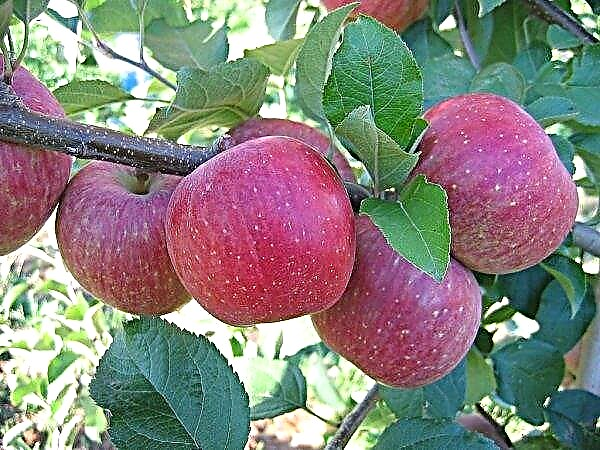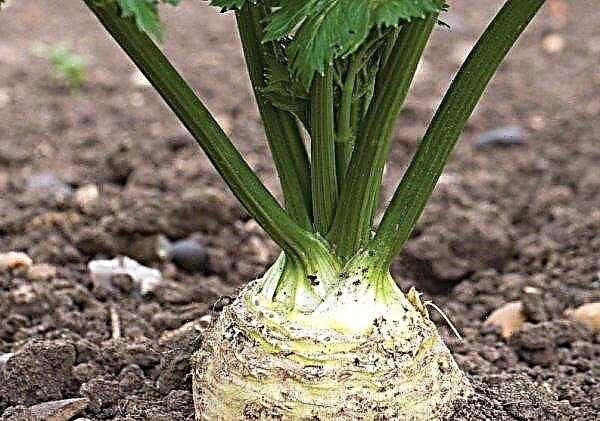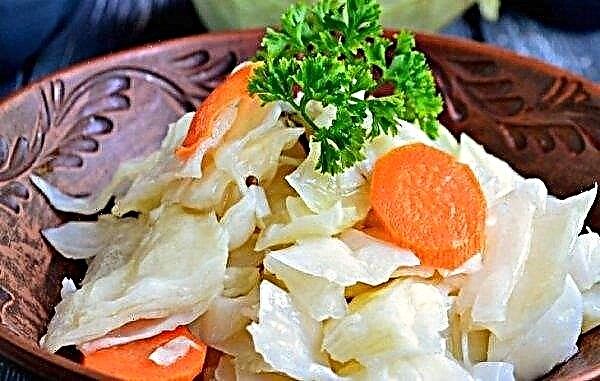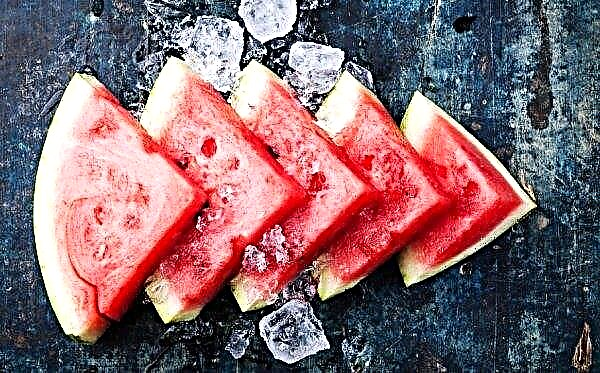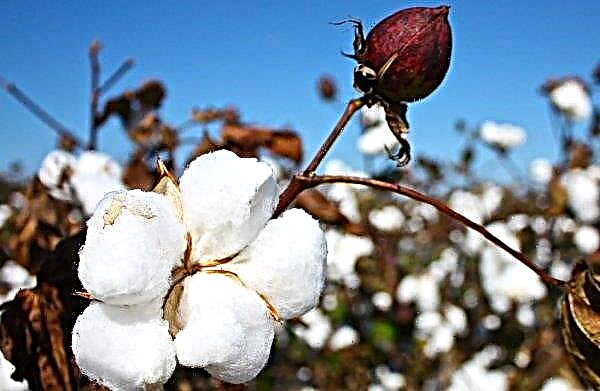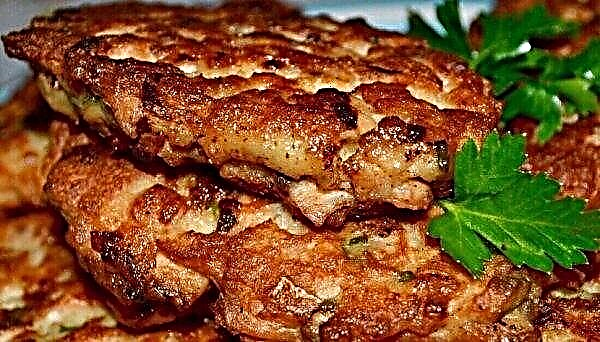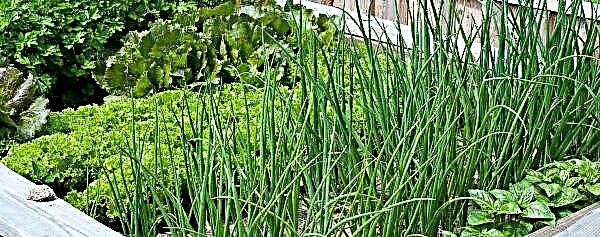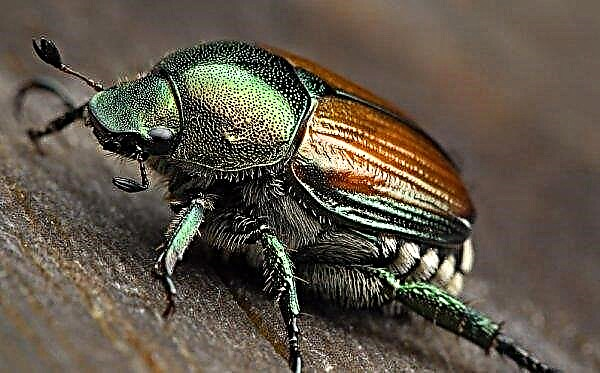The feed can make up to 80% of the cost of pig production, and the better the feed, the better the quality of the pork and its quantity. To improve the quality, enrich the feed with useful vitamins and minerals, premixes were invented. The technology of their use allows to reduce feed consumption per unit weight and improve the health status of animals. It is advisable to know to everyone who starts growing pigs what feeding with premixes gives and which mineral and vitamin complex it is better to choose.
What is premix and what is its benefit
The term “premix” is composed of “pre-” - pre and “-mix” - to mix. It is represented by a filler with a mixture of biologically active substances: vitamins and minerals. Premixes can also be only vitamin or only mineral, as well as combined and supplemented amino acids.
Did you know? Pigs wallow in the mud because they do not sweat, and this is their way of cooling. And the rest — these are the cleanest animals on the farm.
Typical composition of the drug:
- vitamins C, A, D, B, K, PP, E;
- minerals: calcium, zinc, sulfur, magnesium, iodine, selenium, copper, iron;
- filler.

Pigs are divided into several classes:
- piglets up to 10 weeks;
- young fattening pigs;
- sows with piglets;
- adult boars.
For fattening, the presence of vitamins and minerals in the supplement is sufficient. Most of these premixes. And to provide a therapeutic effect, it is necessary that it contains therapeutic substances. So, for example, Tilan 250 premix is an antibacterial drug designed to treat dysentery and other artiodactyl diseases.
Feed antibiotics for disease prevention and enzymes that help nutrients to be better absorbed can also be included. Based on data on the nutrition of pigs and the impact of various components on productive indicators, development companies offer different compositions of premixes.
Dosages and a set of ingredients depend on the task that the drug is designed to solve:
- improvement of productive indicators of adults;
- fattening of young animals;
- improving the composition of the feed that goes to the herd;
- recovery of the animal’s health after illness.

- Useful properties of premixes:
- increased sow productivity;
- improvement in the survival rate and the birth of healthy young animals;
- preventing the death of young animals from intestinal infections;
- improving the absorption of nutrients from feed;
- acceleration of adaptation of young animals to a new type of food;
- 15–30% reduction in feed consumption due to improved nutrient absorption
- regular cleansing of the body of toxins that enter the body with food;
- metabolic acceleration;
- general improvement of the animal organism and improvement of the processes occurring in it;
- strengthening the immunity of animals and reducing morbidity;
- growth acceleration.
Important! Do-it-yourself premix production is complicated by the fact that you do not know the conditions under which one or another component disintegrates or reacts. Some of the components may decay during the preparation process, and you will get a lower-quality product than manufactured industrially.
Advantages and disadvantages of using premixes for fattening pigs
To convert feed into useful substances and energy for the animal, the body carries out a number of complex chemical reactions. But if some ingredients are absent for them, some substances will be partially assimilated or not assimilated at all, which will lead to a slowdown in growth and weight gain.

- Therefore, the advantages of premixes are that they:
- they will certainly deliver the necessary components to the body in the exact dosage;
- improve the quality of the feed and allow you to control its consumption;
- reduce feed costs without affecting livestock;
- help the immune system suppress the development of pathogenic microorganisms.
Since any nutritional supplement is the result of the work of research companies, their composition is verified and balanced, so there are no shortcomings in premixes. Only their improper use or a low-quality product produced by an unscrupulous manufacturer can be found.
Vitamin and chemical composition
Considered additives are presented in three forms.
They can be divided into:
- complete additives;
- mineral and vitamin premixes;
- vitamin supplements.
They include all the essential nutrients except grain. The composition should include protein, basic minerals, trace elements, vitamins. There can be up to 30 elements in a premix, so it is important to know what each of them is for.
Vitamin Premixes
These premixes are designed to enrich feed with vitamins. The composition includes vitamins C, A, D, B, K, PP, E. Usually they are presented in the form of individual vitamins or their complex set. Supplied in the form of solutions, powders and tablets.

May be added to water or feed; intramuscular or subcutaneous administration of drugs is also possible. It should be borne in mind that vitamins do not work on their own - they need medium, water or fat to dissolve, so vitamin premix is usually added to food. It is desirable that it contains a sufficient amount of animal and vegetable proteins.
The characteristic of the vitamin composition:
- Niacin (Vitamin B3 or PP) is necessary to ensure carbohydrate metabolism. It enhances lactation in females.
- Vitamin A necessary for the continuous development of the intestinal mucous membranes, the elimination of diseases of the organs of vision. Its use reduces the likelihood of giving birth to a dead or weak offspring.
- Vitamin D necessary for the absorption of calcium and phosphorus, as well as their transportation and accumulation in bone tissues. It is used to prevent skeletal and joint deformities (rickets) in young animals.
- Vitamin E protects the integrity of epithelial and mucous tissues. It is a biological antioxidant, it contributes to the formation of immunity against diseases. It is necessary for the prevention of muscle diseases in animals and problems associated with fertility.
- Vitamin K prevents blood coagulation, protects bone health, plays an active role in the prevention of obesity. Essential for good animal growth.
Important! Do not forget: the main part of the vitamins enters the body of the animal along with root crops, vegetables and green mass. Therefore, observe the dosage indicated on the premix packaging.
With minerals and trace elements
Minerals are always part of vitamin-mineral complexes and are not supplied separately. The composition usually includes: cobalt, manganese, iron, calcium, potassium, copper, zinc, iodine. They can be supplied in powder form, granules or tablets.
Minerals are obtained by chemical synthesis, fermentation or grinding of the starting material. Chemically prepared components are the most affordable and inexpensive, but in this case the risk to animal health increases due to exposure to chemical solvents that have not reacted intermediate compounds. Such compounds can cause poisoning, so it is recommended that you carefully choose the supplier and study the possibilities of its production.

Characteristics of the mineral composition:
- Iron is essential for transporting blood in the body.
- Zinc is involved in the process of fermentation of food in the intestines. Prevents loss of appetite, growth retardation, and skin problems.
- Copper is required for the synthesis of hemoglobin by iron and the formation of bone tissue. Participates in all oxidative processes. Prevents impaired reproductive function and decreased bone strength.
- Iodine is needed by the thyroid gland to produce the thyroxine hormone, which regulates the body's metabolism. It prevents the birth of weak or dead piglets.
- The body needs cobalt in order to synthesize vitamin B12. Prevents growth retardation and anemia.
- Selenium destroys toxins and prevents the oxidation of the cell membrane. Essential for cell development. It has antioxidant properties, is involved in maintaining the immune system.
Additional items
The pig's body needs amino acids, which are the structural elements of the protein. In the process of digesting food, the protein breaks down into amino acids, and already they form new proteins from which the muscle tissue of the animal is formed. There are 21 essential amino acids for pigs; some of them are available in premixes.
Important! Since you cannot be sure of the quality of processing of raw materials in industrial production, purchase flour in small quantities. And be sure to alternate its different types in the diet.
An excellent result is shown by the use of a protein-vitamin-mineral complex together with various cereal and vegetable flour. You can also alternate the consumption of flour of vegetable and animal origin.
Feed antibiotics - These are natural compounds that are synthesized by a living organism and are able to inhibit the development of pathogens. Some of them inhibit the development of bacteria, others destroy them. The composition of premixes for pigs may include 11 antibacterial or antifungal compounds; Of course, they are not used in the same premix.
In the EU countries, only 2 feed antibiotics are allowed: avilomycin and salinomycin. They are used to stimulate growth and weight. More antibiotics can reduce the incidence of clinical diseases due to the suppression of bacteria. And the premix ability to remove toxins from the body consolidates this healing effect.

Antibiotic feeds are especially important where:
- there is an irregular disinfection and cleaning of the pigsty;
- weight gain is slow;
- young pigs are housed in an old pigsty or to old pigs.
Fast-growing and healthy pigs do not need antibiotic supplements. It is also advisable to consider the time before slaughter. Remember that animal meat after antibiotic treatment may not be suitable for food.
Enzymes - Another component that may be part of the complex. Fermentation increases the nutritional value of the feed. At the same time, that part of the nutrients that would not be digested and not used without them is released from it. Enzymes are especially needed for piglets - during the first 5–7 weeks, their body does not cope well with other foods except mother's milk.
Did you know? A pig is one of the first animals domesticated by humans, which happened about 6,000 years ago.
The use of enzymes can increase the gain in live weight by 40%. In the future, young animals will need enzymes when switching to cereal feed; it will also help reduce the risk of bowel upset and diarrhea.
Best premixes for fattening pigs
Today, the market offers a wide selection of feed additives, probiotics, medicines, vitamin and mineral complexes and other products for raising pigs. When choosing from the assortment, it is worth paying attention to the completeness of the information provided, the composition and dosage of your goals, the reputation of the manufacturer, the cost and reviews of the drugs.
"Borka"
Vitamin and mineral premix “Borka” was developed by the company “Karital-PROK” JSC. Designed to provide pigs with a complete set of necessary biologically active components. The company not only develops, but also improves its products, taking into account customer reviews and consumption results. All raw materials undergo complete control, which guarantees the highest quality in accordance with industry standards.

"Borka" increases the immunity of livestock, increases the gain of young animals and improves the composition of feed consumed by pets. The composition contains 6 vitamins: A, B1, B2, B3, B5, D3, as well as minerals: calcium, phosphorus, iodine, zinc, manganese, copper. It does not contain antibiotics or growth stimulants, but it has antioxidants and amino acids, which positively affects digestion and weight gain. Dosage - 10 g premix per 1 kg of feed.
"Good Peasant"
The line of additives "Good Peasant" from the manufacturer LLC "Miagro" for pigs is available in 4 versions:
- additive for dairy pigs;
- supplement for pregnant and lactating pigs;
- supplement for fattening pigs;
- anthelmintic supplement.
The composition of each product includes vitamins and minerals. It does not contain hormones and growth stimulants. The product is packaged in dry powder form. Specialists of the All-Russian Scientific Institute of Animal Husbandry took part in the development of the compositions, which guarantees high quality and effectiveness of the product.
The Gift of Veles
The Premix “Dar Veles” is characterized by an effective set of components, ensuring the fertility of sows and high livestock productivity. The complex is balanced in composition and takes into account more than 20 indicators. In addition to vitamins and minerals, it includes enzymes and amino acids, so it can be used for dairy pigs and for young animals during the transition to grain feeds.

Systematic use of the product increases the immunity of animals, increases the viability of the offspring, enhances lactation in sows and reduces food consumption by 15–25%. The feeding period is reduced by several weeks.
It contains 12 vitamins: A, B1, B2, B3, B5, B6, B12, Sun, H, E, K, D3 and 10 minerals: phosphorus, calcium, manganese, iodine, cobalt, magnesium, zinc, iron, selenium, copper, as well as an enzymatic probiotic. The manufacturer is the BioPro company. Delivered in dry packaging. The dosage of the drug depends on the age of the animal and is indicated on the package.
"Borya-Champion"
Premix “Borka-Champion” contains a vitamin-mineral complex, as well as a number of vegetable proteins. It contains 12 vitamins: A, B1, B2, B3, B5, B6, B12, Sun, H, E, K, D3 and 6 minerals: iron, copper, selenite, zinc, iodine, manganese. Bran and chalk are used as filler. Dosage - 40 g premix per 1 kg of feed.

It is used for fattening pigs. It can be used to prevent rickets and deviations in the development of the musculoskeletal system. Among the advantages of the drug is a positive effect on the survival of piglets and the overall health of the pigs.
Norms and basic rules for using premixes
The task of any premix is to satisfy a specific need:
- help dairy pigs move from breast milk to other foods;
- improve sows fertility;
- speed up fattening and so on.
Important! Without exception, all minerals in large quantities are toxic, so carefully observe the dosage of any additives in the diet of your pets.
The choice of premix will depend on the purpose. Pay attention to the purpose of the components described in the article, and compare it with the composition of the premix - if it contains the components you need, then you can safely buy. The table below shows the norms for using premix components (or additives) per 1 ton of feed at various stages of animal growth.
| Component | For piglets | Fattening | For sows |
| Vitamin A (UI) | 5 | 3 | 5 |
| Vitamin D (UI) | 500 | 300 | 500 |
| Vitamin E (UI) | 20 | 10 | 25 |
| vitamin K (g) | 2 | 2 | 2 |
| vitamin B2 (g) | 4 | 5 | 5 |
| Vitamin PP (g) | 30 | 30 | 30 |
| Vitamin B5 (g) | 16 | 8 | 18 |
| Vitamin B4 (g) | 200 | 100 | 700 |
| Vitamin B12 (g) | 25 | 12 | 25 |
Due to the unstable content of vitamins in natural feed for pigs and their relatively low cost, it is advisable to fully calculate the daily rate, focusing on the premix and not taking into account their content in natural feed. This applies to all of the above vitamins.

Rules for using premixes:
- Add to cooled wet food at room temperature. Heat treatment leads to the breakdown of vitamins.
- Follow the rules on the packaging. The body will not be able to absorb 2 times more of one or another component, and what is not used will be excreted from the body with urine and feces. Therefore, there is no point in double dosages.
- Take into account the age group and your goal, do not use inappropriate premix for the purposes. Pigs will assimilate it, but you will not get the desired result.
- Use premix with quality feed. Vitamins are absorbed in combination with other components and these components must be in the feed.
- Do not use expired supplements. Minerals will remain in it, but vitamins - no.
- Start with a small amount and gradually increase it to normal.
- Add premix only to fresh, wet foods.
- Use supplements 1-2 times a day.
Video: Pig growth dynamics at bmvd and premix
Recommendations when choosing premixes
When choosing a premix, it is worth paying attention to a number of factors, such as the composition of the additive, the reputation of the manufacturer and others.
When preparing premixes, you can go in several ways:
- buy ready-made from an independent feed mill;
- purchase individual raw materials and mix them yourself.
Did you know? Of all farm animals, pigs have the best sense of smell, so they are used in modern armies to search for mines. And in France since In the 15th century, pigs were trained to search for valuable truffles mushrooms underground.
When deciding on a supplier, consider:
- reliability and reputation of the manufacturer;
- expected productivity in terms of costs per kilogram of pork and growth rate;
- availability of a quality control program with the manufacturer;
- availability of certificates confirming product quality.
If you get a premix with antibiotics, then keep in mind that the treatment process goes like a course and lasts for a certain time. And after the end of treatment, such an additive must be replaced with a premix for pigs of your growth category. If animals suffer from intestinal disorders - choose a premix, the properties of which indicate an antitoxic orientation. Toxins are often found in natural feed; it depends on the growing conditions of vegetables and root crops, as well as on the drugs that they were processed.
If animals suffer from intestinal disorders - choose a premix, the properties of which indicate an antitoxic orientation. Toxins are often found in natural feed; it depends on the growing conditions of vegetables and root crops, as well as on the drugs that they were processed.
Use high-quality feed, add the necessary premixes, and you are sure to get a sufficient amount of high-quality products. When using useful supplements, keep track of the results - so it will be easier for you to track the effectiveness of the drug used.

